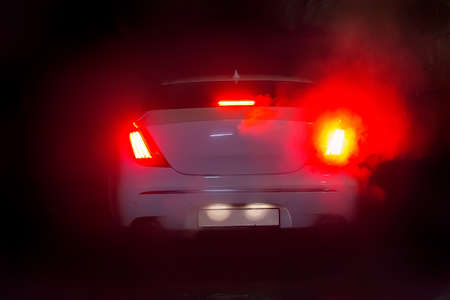1. Introduction to Red Light and Stop Sign Violations
Traffic signals and stop signs play a crucial role in maintaining order on the roads. Ignoring them can lead to accidents, fines, and other serious consequences. Understanding traffic laws related to red lights and stop signs helps drivers make safer decisions and avoid violations.
Understanding Traffic Signals and Stop Signs
Traffic signals and stop signs are designed to regulate the flow of vehicles and pedestrians. They ensure that everyone has a fair chance to cross intersections safely. Disregarding these signals can result in dangerous situations and legal trouble.
Basic Rules for Red Lights and Stop Signs
| Type of Signal | Rule |
|---|---|
| Red Light | Come to a complete stop and wait for the green light before proceeding. |
| Flashing Red Light | Treat it as a stop sign; stop completely and proceed when safe. |
| Stop Sign | Come to a full stop, check for other vehicles and pedestrians, and proceed when safe. |
| Right Turn on Red | Allowed in most states after a complete stop, unless a sign prohibits it. |
Why Following These Rules Is Important
Running a red light or stop sign increases the risk of accidents. Intersections are already high-risk areas, and failing to stop can lead to collisions, injuries, or even fatalities. By obeying these laws, you help keep the roads safer for everyone.
Legal Consequences of Violations
Law enforcement officers issue citations to drivers who ignore traffic signals. These citations can lead to fines, points on your driving record, and even license suspension. Knowing and following the rules can help you avoid penalties and maintain a clean driving record.
2. Consequences of Running a Red Light or Stop Sign
Running a red light or stop sign can have serious consequences, both legally and financially. Understanding these penalties can help you avoid violations and keep your driving record clean.
Legal Penalties and Fines
Each state has its own traffic laws, but in general, fines for running a red light or stop sign range from $50 to $500. In some states, additional fees may apply depending on the severity of the violation.
| State | Typical Fine | Additional Penalties |
|---|---|---|
| California | $100 – $500 | Possible traffic school |
| Texas | $75 – $200 | Court fees may apply |
| New York | $150 – $400 | Points added to record |
Points on Your Driving Record
Most states use a point system for traffic violations. If you accumulate too many points, you may face higher fines, mandatory driving courses, or even license suspension.
| Violation | Typical Points Added |
|---|---|
| Running a red light | 2 – 4 points |
| Failing to stop at a stop sign | 1 – 3 points |
License Suspension
Repeated violations can lead to license suspension. In some states, accumulating 10 or more points within a year can result in losing driving privileges for a certain period.
Increased Insurance Rates
Insurance companies monitor your driving record. A red light or stop sign violation may increase your premiums because insurers see it as risky driving behavior.
How Much Can Insurance Rates Increase?
Depending on your insurer and location, your premium could go up by 10% to 30% after a single violation.
Ways to Minimize Insurance Rate Increases
- Attend traffic school (if allowed in your state)
- Maintain a clean driving record moving forward
- Shop around for better insurance rates
Understanding these consequences can help you make better driving decisions and avoid unnecessary penalties.
![]()
3. How Law Enforcement Detects Violations
Running a red light or failing to stop at a stop sign can be dangerous and costly. Law enforcement agencies use several methods to catch drivers who violate these traffic laws. Understanding how these methods work can help you stay compliant and avoid fines.
Red-Light Cameras
Red-light cameras are automated systems installed at certain intersections to capture vehicles that run red lights. These cameras operate using sensors embedded in the road. When a vehicle enters the intersection after the light has turned red, the camera takes a photo or video of the vehicle, including its license plate.
How Red-Light Cameras Work
- Sensors detect when a vehicle crosses into the intersection after the light turns red.
- The camera captures images or video of the violation.
- The evidence is reviewed by law enforcement before issuing a citation.
Police Patrols
Law enforcement officers often monitor intersections where red-light running is a common problem. Officers may be stationed in marked or unmarked patrol cars, watching for violations. When they witness a driver running a red light or failing to stop at a stop sign, they can pull them over and issue a ticket.
Methods Used by Police Patrols
- Watching high-risk intersections.
- Using dash cameras to record violations.
- Responding to citizen complaints about problem areas.
Other Monitoring Methods
In addition to red-light cameras and police patrols, authorities use various technologies and strategies to enforce traffic laws.
| Method | Description |
|---|---|
| License Plate Recognition (LPR) Systems | Automated cameras that scan license plates and check for violations. |
| Undercover Officers | Law enforcement officers in unmarked cars monitoring high-risk areas. |
| Intersection Surveillance | CCTV cameras used to monitor driver behavior at intersections. |
By understanding how law enforcement detects traffic violations, drivers can be more mindful on the road and avoid unnecessary fines. Staying alert, slowing down, and following traffic signals at all times will help keep the roads safer for everyone.
4. Tips to Avoid Running Red Lights and Stop Signs
Running red lights and stop signs can be dangerous and costly. However, with the right driving habits, you can prevent these violations and ensure your safety on the road. Below are practical strategies to help you stay compliant with traffic laws.
Practice Defensive Driving
Defensive driving helps you stay prepared for unpredictable road conditions. Follow these key defensive driving strategies:
- Always scan the road ahead and check for potential obstacles or signal changes.
- Maintain a safe following distance to give yourself ample reaction time.
- Anticipate the actions of other drivers, especially at intersections.
Stay Alert and Avoid Distractions
Driver inattention is a major cause of traffic violations. To stay focused:
- Avoid using mobile devices while driving.
- Limit in-car distractions such as eating or adjusting the radio.
- Be especially cautious when approaching intersections.
Understand Traffic Light Timing
Knowing how traffic lights change can help you react appropriately. Consider these factors:
| Traffic Light Behavior | What You Should Do |
|---|---|
| Green Light Turning Yellow | Prepare to slow down and stop unless it is unsafe to do so. |
| Red Light | Come to a complete stop and wait for the green signal. |
| Flashing Red Light | Treat it as a stop sign—stop completely and proceed when safe. |
| Flashing Yellow Light | Slow down and proceed with caution. |
Be Mindful at Stop Signs
A complete stop is required at stop signs, even if you think the road is clear. Follow these steps:
- Come to a full stop behind the stop line or crosswalk.
- Look both ways and ensure no other vehicles or pedestrians have the right-of-way.
- Proceed only when it is safe to do so.
Plan Your Route to Avoid Rushed Decisions
Rushing can lead to risky maneuvers. To avoid this, plan ahead:
- Leave early to reduce the temptation to speed or run lights.
- Familiarize yourself with intersections along your route.
- Use navigation apps to anticipate traffic and signal timing.
By applying these practical strategies, you can significantly reduce your chances of running red lights or stop signs. Safe driving not only helps you avoid fines but also keeps you and others on the road protected.
5. What to Do If You Get a Ticket
Receiving a ticket for running a red light or failing to stop at a stop sign can be frustrating, but it’s important to handle it promptly. Here are the steps you should take after getting cited.
Step 1: Review the Citation
First, carefully read the ticket. It will include important details such as:
- The violation you were cited for
- The date, time, and location
- The deadline to respond
- Payment and contesting options
Step 2: Decide How to Respond
You have several options when dealing with a traffic ticket. Choose the one that best fits your situation:
| Option | Description |
|---|---|
| Pay the Fine | Accept the ticket and pay the fine online, by mail, or in person. |
| Contest the Ticket | Request a court hearing to challenge the citation with evidence or witness testimony. |
| Attend Traffic School | Reduce penalties and keep points off your record by completing an approved course. |
Step 3: Pay the Fine (If You Choose to Accept)
If you decide to pay the fine, do so before the deadline to avoid additional penalties. Most courts offer multiple payment methods:
- Online payment through the court’s website
- Mailing a check or money order
- Paying in person at the courthouse
Step 4: Contest the Ticket (If You Believe It Was Unjustified)
If you think the citation was issued in error, you can contest it. Here’s how:
- Request a court hearing before the deadline.
- Gather evidence such as photos, witness statements, or dashcam footage.
- Present your case in front of a judge or hearing officer.
- Await the final decision—if the ticket is dismissed, you won’t have to pay.
Step 5: Consider Traffic School
Many states allow eligible drivers to attend traffic school to reduce the impact of a ticket. Benefits include:
- Preventing points from being added to your driving record
- Potentially lowering insurance rate increases
- Learning safer driving habits
Check with your local court to see if you qualify and register for an approved course.
Step 6: Follow Up
Regardless of your choice, make sure to follow up and confirm everything is processed correctly. If you paid the fine, check that the payment was received. If you contested the ticket, monitor the case status. Staying organized can help you avoid additional penalties or late fees.


